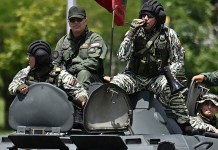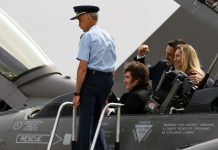Sudan’s two-year-old civil war is taking a dangerous turn as advanced foreign weapons, including drones and air defense systems, pour into the impoverished African country.
Earlier this week, anti-government forces destroyed a cutting-edge Turkish Akinci attack drone, which was in service with the government army, using Chinese air defense systems.
According to the footage published by a well-known military analyst on social media, the drone was shot down by the so-called Rapid Support Forces (anti-government) in northern Darfur.
The shooting down of the Akinci drone by the anti-government forces using Chinese air defense systems once again highlights the internationalization of the conflict in one of the world’s most impoverished countries.
Furthermore, this is not the first incident of advanced Turkish attack drones being shot down by the rebel forces in Sudan.
According to a recent Washington Post report, the Sudanese rebel forces have shot down at least three advanced Turkish attack drones, including Akinci and Bayraktar TB2, between August and September.
The latest incident indicates that rebel forces have shot down four Turkish drones in the last two months.
Additionally, notwithstanding the poor living standards of the Sudanese people, the country has entered the age of drone warfare, with both sides using advanced drones in their civil war.
Most of the arms transfers are discreet and through third parties, and there are no official confirmations; however, according to reports and defense analysts, the government forces led by the Sudanese Army are mostly using Turkish drones and ground systems, while the opposition forces led by the Rapid Support Forces (RSF) are mostly using Chinese drones.

According to some reports, the UAE bought and supplied Chinese drones to the RSF rebel forces. However, the UAE has rejected these claims.
Drone Warfare In The World’s Poorest Country
According to the Global Finance Magazine, both Sudan and South Sudan (separated from Sudan in 2011) count among the world’s poorest countries.
According to the IMF, in 2025, the average GDP per capita in South Sudan was US$716, whereas in Sudan, it was US$2,335. For perspective, the average GDP per capita in Saudi Arabia, which is just across the Red Sea from Sudan, was approximately US$62,000.
In Turkey, which supplies its advanced drones to the Sudanese government forces, the average GDP per capita in 2025, according to the IMF, was US$42,450.
According to a recent United Nations report, Turkey has supplied the Sudanese Armed Forces with TB2 and Akinci drones as well as ground control systems through intermediaries.
The UN estimated the value of the transfers at around US$120 million.
The UAE, which, according to some unconfirmed reports, is buying weapons for the rebel forces, has an average GDP per capita of US$81,680.
China, whose air defense systems and drones are being used by the rebel forces, has an average GDP per capita of US$28,980.
Notwithstanding the extreme poverty of the Sudanese people, both sides are using advanced drones.
While the government forces have used advanced Akinci and Bayraktar TB2 drones for more than a year, the latest reports suggest that some of these drones are being launched from Egypt.
Independent sources suggest that the satellite imagery appears to show Turkish-built Akinci drones stationed at East Oweinat Airport in Southwestern Egypt, near the borders with Sudan.
Nigeria-based VanguardNGR first published the findings, which suggest that cross-border operations against the Sudanese rebel forces are being conducted through Egypt.
The reports come amid rising concern over international involvement in the Sudanese civil war, despite a UN-backed arms embargo in Darfur in place since October 2024.
Turkish Drones Losing Steam?
The repeated downings of the advanced Turkish drones have raised another question: are the Turkish drones losing steam?
The Turkish drones were the decisive factor in Azerbaijan’s victory over Armenia in the Nagorno-Karabakh region in 2020 and 2023.
Furthermore, the Turkish drones played a decisive role in Ukraine’s counteroffensive against Russian forces in 2022 and the early part of 2023.
The combat success of these drones helped Turkey establish itself as a major player in the global combat drone market.

The TB2 has been exported to over 34 countries, generating significant revenue.
In 2023, Baykar generated 90% of its revenue from international markets, with exports reaching US$1.8 billion, up from US$1.2 billion in 2022, thereby contributing to Turkey’s overall defense exports.
In the competitive combat and ISR drone market, Turkey has emerged as a world leader (65% share), significantly surpassing traditional arms export leaders, such as the US (8% share) and China (26% share).
In fact, drone exports constituted nearly one-third of Türkiye’s record-breaking US$5.5 billion defense exports in 2023, with Baykar leading the charge.
However, the Turkish drones are no longer invincible.
Even in the Russia-Ukraine war, the Turkish drones were not as effective once the Russian military developed electronic countermeasures against them.
In the India-Pakistan War during May this year, multiple Turkish drones, such as Asisguard Songar and Byker YIHA III kamikaze drones, were shot down by India.
Of late, even rebel militant forces, such as Libyan National Army (LNA) militants in Libya, Kurdish militants in Iraq and Syria, and RSF forces in Sudan, have developed effective countermeasures against Turkish drones.
According to media reports and rebel claims, at least six Akinci drones operated by the Sudanese government forces have been shot down by RSF forces since June this year.
The Bayraktar Akinci is a Turkish high-altitude and long-endurance (HALE) drone developed by Baykar. This drone is capable of carrying a variety of weapons, including precision-guided missiles, guided bombs, and cruise missiles.
The rebel forces in Sudan have also published pictures and videos of these shootings on numerous occasions to support their claims.
#Sudan 🇸🇩: "Rapid Support Forces" (#RSF) destroyed a Drone (UAV) operated by Sudanese Forces (#SAF) over Al-Fashir, North #Darfur.
📌
Seemingly RSF shot down a Baykar Bayraktar "AKINCI" HALE UCAV which was made by #Turkey (#Türkiye) 🇹🇷 and alter supplied to the SAF. pic.twitter.com/UVpZQabzkT— RSSD (@DaNiDel94594165) July 13, 2025
In the latest incident, analysts suggest that a Chinese anti-aircraft missile shot down the drone.
Notably, earlier this week, investigative journalists from the Chadian publication TchadOne reported that China, with funding from the United Arab Emirates, transferred the FB 10-A short-range air defense system to the Sudanese rebel group ‘Rapid Support Forces’. Chad acted as a conduit to bypass the arms embargo.
According to the report, in February 2025, the Chadian Air Force signed a letter of intent to purchase the FB-10-A missile system from a large Chinese state-owned corporation.
“Barely delivered, the systems disappeared from the army’s inventory and later ‘surfaced’ in Sudan – blatantly violating the international arms embargo,” the report said.
Sudan 🇸🇩: Picture showing a chinese made Wolves Team anti-drone jammer system mounted on a Toyota pick-up of the Rapid Support Forces. pic.twitter.com/N2pprHonb2
— Hammer Of War (@HammerOfWar5) October 6, 2025
According to Open Source Intelligence accounts, Sudanese rebel forces are also reportedly using Chinese electronic warfare systems on their off-road vehicles.
The Sudanese rebel forces are also using Chinese drones to strike the positions of the government forces.
According to a recent Amnesty International report, the RSF forces are using Chinese-made drones, purchased and supplied by the UAE, to strike government forces.
“A new investigation by Amnesty International has revealed that sophisticated Chinese weaponry, provided by the United Arab Emirates (UAE), is being used by the Rapid Support Militia (Janjaweed) in Sudan in violation of the United Nations arms embargo on Darfur,” the report said.
Thanks to these Chinese drones and air defense systems, the Sudanese rebels have narrowed the gap with government forces in terms of aerial supremacy.
These developments suggest that Turkish and Chinese weapons, including combat drones, are pitted against each other in Sudan.
Interestingly, Turkey and China are the two biggest players in the global export market for combat drones.
Many countries around the globe will keenly watch the outcome of this Chinese vs Turkish drone contest in Sudan.
- This is an Opinion Article




